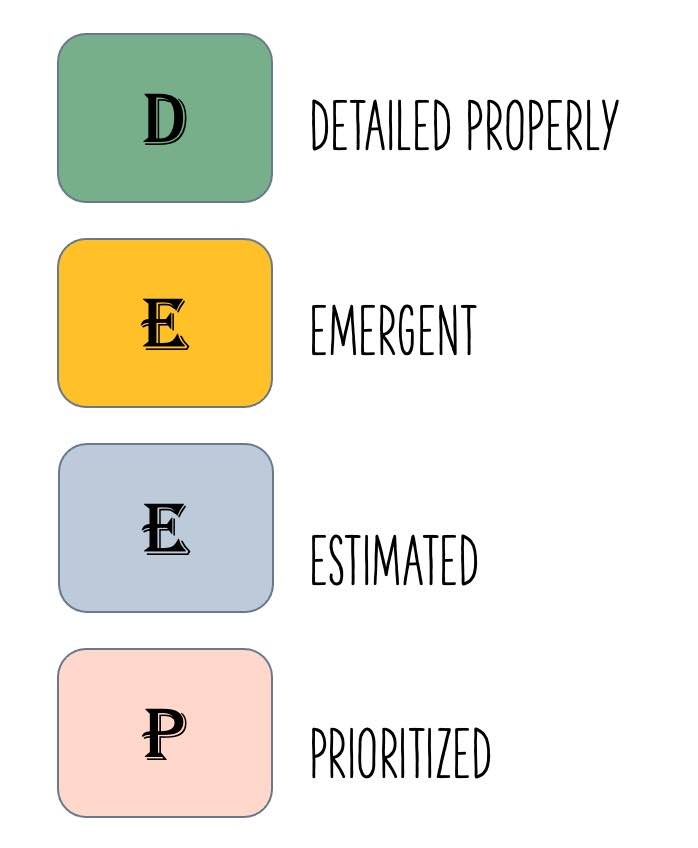In this article, we will discuss the vital role that product backlog plays in a scrum-based project.
Table of Contents:
- Product Backlog Items
- Characteristics of Product Backlog
- Product Backlog Grooming
- Example of Product Backlog
- Closing
Product Backlog is a prioritzed list of product functionality that should be accessible to all the team members.
Product backlog forms the heart of the Scrum framework.
video tutorial on product backlog in scrum
Product Backlog Items #
Product Backlog Items, also called PBIs, consist of the items that include everything required to get the project/ product completed, such as new features and changes to the product’s existing features.
Below is a list of common PBIs:
- New functionality of the product.
- Custom changes by customers on old functionality /features of the product.
- Defects.
- Technical improvement work including reducing the technical debt.
- Training/ sessions for knowledge acquisition.
- Any other work approved by the product owner.

PBIs
Characteristics of Product Backlog #
Like we have INVEST criteria to write a good user story, there are specific characteristics of a good product backlog. DEEP is a similar criterion for managing and organizing product backlog.

DEEP - Criterion
DEEP stands for:
D- DETAILED APPROPRIATELY
The term detailed appropriately does not mean that all the PBIs should be detailed enough that anyone can start working on them immediately. Instead, it means that they should have an appropriate level of detail. The PBIs on the top of the list should have more information because we plan to work on them quite soon. The PBIs at the end of the list will be bigger and might not have the full details.
E- EMERGENT
We can never say that a product backlog is frozen or complete as a Product Backlog is constantly emerging with customers’ new changes and needs because of the ever-changing market. Hence the Product Backlog is never constant. With the upcoming and further information, the product backlog should be re-prioritized to maintain the balance.
E-ESTIMATED
Each product backlog item has an estimated size corresponding to the effort required to develop the backlog item. These estimations can be either in story points (Fibonacci series count), T-shirt sizes (S, M, L, XL, XXL), Bucket sizes, etc. The team should work on estimating the PBIs through the grooming sessions.
P- PRIORITIZED
The product owner and the rest of the team should work on prioritizing the product backlog.
What if the list of backlog items is too long?
It is unlikely to say that all the PBIs will always be prioritized, but the team should always keep the backlog prioritized for the items that should be part of a few upcoming sprints. Also, while working on development items team might discover some new items. These new items should be prioritized and placed in the correct order. Similarly, when a customer specifies any new functionality, the product owner should insert them in the correct order.
Product Backlog Grooming #
Let us discuss the WHAT, WHO, and WHEN of backlog grooming.
WHAT IS PRODUCT BACKLOG GROOMING? #
Backlog grooming is an activity to refine, estimate and prioritize the product backlog. During the backlog grooming, the backlog items are pulled, detailed discussions are done related to technical and functional dependencies, any other constraints, etc., on each PBI. In grooming meetings, the team divides backlog items into smaller, more manageable PBIs and sizes them.
WHO DOES PRODUCT BACKLOG GROOMING? #
Backlog grooming is a collaborative effort done by the product owner, development team members, scrum master, and other critical internal and external stakeholders.
Though it is the responsibility of a product owner to manage and prioritize the product backlog, a good product owner does it with active participation from the other scrum team participants. Grooming the backlog together saves a lot of time later, making everyone understand what the item is all about.
WHEN IS BACKLOG GROOMING DONE? #
Though the scrum framework provides no strict guidelines, backlog grooming should be an ongoing activity. Different teams have set up backlog grooming meetings at different frequencies, whatever suits the team and the organization. While the frequency of backlog grooming is decided as per team, it should not consume more than 10% of its capacity. However, a product owner can revise it anytime the need arises.
Grooming is an important activity and should be integrated with scrum development flow.
Example of Product Backlog #
The below image is an example of a product backlog from a clinical system. Since it is just for demonstration purposes, only ten issues are shown here, but the number of PBIs is much higher in the actual development projects.

product backlog example
Closing #
There is a crucial role of product backlog in a scrum development project to achieve a fast and valuable delivery.
We hope this article helped you to build a good understanding of product backlog in scrum development projects. Good Luck with your upcoming backlog grooming meeting !!!